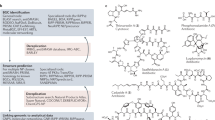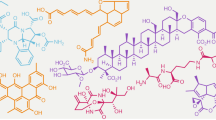Abstract
Burkholderia species have emerged as a new source of diverse natural products. This mini-review covers all of the natural products discovered in recent years from Burkholderia sp. by genome-guided approaches—these refer to the use of bacterial genome sequence as an entry point for in silico structural prediction, wet lab experimental design, and execution. While reliable structural prediction based on cryptic biosynthetic gene cluster sequence was not always possible due to noncanonical domains and/or module organization of a deduced biosynthetic pathway, a molecular genetic method was often employed to detect or alter the expression level of the gene cluster to achieve an observable phenotype, which facilitated downstream natural product purification and identification. Those examples of natural product discovery from Burkholderia sp. provide practical guidance for future exploration of Gram-negative bacteria as a new source of natural products.







Similar content being viewed by others
References
Bayro MJ, Mukhopadhyay J, Swapna GV, Huang JY, Ma LC, Sineva E, Dawson PE, Montelione GT, Ebright RH (2003) Structure of antibacterial peptide microcin J25: a 21-residue lariat protoknot. J Am Chem Soc 125:12382–12383
Biggins JB, Gleber CD, Brady SF (2011) Acyldepsipeptide HDAC inhibitor production induced in Burkholderia thailandensis. Org Lett 13:1536–1539
Biggins JB, Liu X, Feng Z, Brady SF (2011) Metabolites from the induced expression of cryptic single operons found in the genome of Burkholderia pseudomallei. J Am Chem Soc 133:1638–1641
Biggins JB, Ternei MA, Brady SF (2012) Malleilactone, a polyketide synthase-derived virulence factor encoded by the cryptic secondary metabolome of Burkholderia pseudomallei group pathogens. J Am Chem Soc 134:13192–13195
Blin K, Medema MH, Kazempour D, Fischbach MA, Breitling R, Takano E, Weber T (2013) antiSMASH 2.0–a versatile platform for genome mining of secondary metabolite producers. Nucleic Acids Res 41:W204–W212
Brady SF, Bauer JD, Clarke-Pearson MF, Daniels R (2007) Natural products from isnA-containing biosynthetic gene clusters recovered from the genomes of cultured and uncultured bacteria. J Am Chem Soc 129:12102–12103
Carr G, Seyedsayamdost MR, Chandler JR, Greenberg EP, Clardy J (2011) Sources of diversity in bactobolin biosynthesis by Burkholderia thailandensis E264. Org Lett 13:3048–3051
Challis GL (2008) Genome mining for novel natural product discovery. J Med Chem 51:2618–2628
Cheng Y-Q, Yang M, Matter AM (2007) Characterization of a gene cluster responsible for the biosynthesis of anticancer agent FK228 in Chromobacterium violaceum No. 968. Appl Environ Microbiol 73:3460–3469
Coenye T, Vandamme P (2003) Diversity and significance of Burkholderia species occupying diverse ecological niches. Environ Microbiol 5:719–729
Compant S, Nowak J, Coenye T, Clement C, Ait Barka E (2008) Diversity and occurrence of Burkholderia spp. in the natural environment. FEMS Microbiol Rev 32:607–626
Corre C, Challis GL (2009) New natural product biosynthetic chemistry discovered by genome mining. Nat Prod Rep 26:977–986
Dance DA (2002) Melioidosis. Curr Opin Infect Dis 15:127–132
Darst SA (2004) New inhibitors targeting bacterial RNA polymerase. Trends Biochem Sci 29:159–160
Dvorak GD, Spickler AR (2008) Glanders. J Am Vet Med Assoc 233:570–577
El-Elimat T, Figueroa M, Raja HA, Graf TN, Adcock AF, Kroll DJ, Day CS, Wani MC, Pearce CJ, Oberlies NH (2013) Benzoquinones and terphenyl compounds as phosphodiesterase-4B inhibitors from a fungus of the order Chaetothyriales (MSX 47445). J Nat Prod 76:382–387
Franke J, Ishida K, Hertweck C (2012) Genomics-driven discovery of burkholderic acid, a noncanonical, cryptic polyketide from human pathogenic Burkholderia species. Angew Chem Int Ed 51:11611–11615
Furumai R, Matsuyama A, Kobashi N, Lee KH, Nishiyama M, Nakajima H, Tanaka A, Komatsu Y, Nishino N, Yoshida M, Horinouchi S (2002) FK228 (depsipeptide) as a natural prodrug that inhibits class I histone deacetylases. Cancer Res 62:4916–4921
Galyov EE, Brett PJ, DeShazer D (2010) Molecular insights into Burkholderia pseudomallei and Burkholderia mallei pathogenesis. Annu Rev Microbiol 64:495–517
Garcia-Osta A, Cuadrado-Tejedor M, Garcia-Barroso C, Oyarzabal J, Franco R (2012) Phosphodiesterases as therapeutic targets for Alzheimer’s disease. ACS Chem Neurosci 3:832–844
Hegemann JD, Zimmermann M, Zhu S, Klug D, Marahiel MA (2013) Lasso peptides from proteobacteria: genome mining employing heterologous expression and mass spectrometry. Biopolymers 100:527–542
Ishida K, Lincke T, Behnken S, Hertweck C (2010) Induced biosynthesis of cryptic polyketide metabolites in a Burkholderia thailandensis quorum sensing mutant. J Am Chem Soc 132:13966–13968
Ishida K, Lincke T, Hertweck C (2012) Assembly and absolute configuration of short-lived polyketides from Burkholderia thailandensis. Angew Chem Int Ed 51:5470–5474
Jain A, Liu X, Wordinger RJ, Yorio T, Cheng Y-Q, Clark AF (2013) Effects of thailanstatins on glucocorticoid response in trabecular meshwork and steroid-induced glaucoma. Invest Ophthalmol Vis Sci 54:3137–3142
Knappe T, Linne U, Zirah S, Rebuffat S, Xie XL, Marahiel M (2008) Isolation and structural characterization of capistruin, a lasso peptide predicted from the genome sequence of Burkholderia thailandensis E264. J Pept Sci 14:97
Knappe TA, Linne U, Robbel L, Marahiel MA (2009) Insights into the biosynthesis and stability of the lasso peptide capistruin. Chem Biol 16:1290–1298
Kumar N, Goldminz AM, Kim N, Gottlieb AB (2013) Phosphodiesterase 4-targeted treatments for autoimmune diseases. BMC Med 11:96
Lazar Adler NR, Govan B, Cullinane M, Harper M, Adler B, Boyce JD (2009) The molecular and cellular basis of pathogenesis in melioidosis: how does Burkholderia pseudomallei cause disease? FEMS Microbiol Rev 33:1079–1099
Lee IK, Yun BS, Cho SM, Kim WG, Kim JP, Ryoo IJ, Koshino H, Yoo ID (1996) Betulinans A and B, two benzoquinone compounds from Lenzites betulina. J Nat Prod 59:1090–1092
Liu X, Biswas S, Berg MG, Antapli CM, Xie F, Wang Q, Tang MC, Tang GL, Zhang L, Dreyfuss G, Cheng Y-Q (2013) Genomics-guided discovery of thailanstatins A, B, and C As pre-mRNA splicing inhibitors and antiproliferative agents from Burkholderia thailandensis MSMB43. J Nat Prod 76:685–693
Mahenthiralingam E, Urban TA, Goldberg JB (2005) The multifarious, multireplicon Burkholderia cepacia complex. Nat Rev Microbiol 3:144–156
Maksimov MO, Pan SJ, James Link A (2012) Lasso peptides: structure, function, biosynthesis, and engineering. Nat Prod Rep 29:996–1006
Medema MH, Blin K, Cimermancic P, de Jager V, Zakrzewski P, Fischbach MA, Weber T, Takano E, Breitling R (2011) antiSMASH: rapid identification, annotation and analysis of secondary metabolite biosynthesis gene clusters in bacterial and fungal genome sequences. Nucleic Acids Res 39:W339–W346
Michalski JM, Golden G, Ikari J, Rennard SI (2012) PDE4: a novel target in the treatment of chronic obstructive pulmonary disease. Clin Pharmacol Ther 91:134–142
Minowa Y, Araki M, Kanehisa M (2007) Comprehensive analysis of distinctive polyketide and nonribosomal peptide structural motifs encoded in microbial genomes. J Mol Biol 368:1500–1517
Nakagawa F, Enokita R, Naito A, Iijima Y, Yamazaki M (1984) Terferol, an inhibitor of cyclic adenosine 3’,5’-monophosphate phosphodiesterase. I. Isolation and characterization. J Antibiot (Tokyo) 37:6–9
Nakagawa F, Takahashi S, Naito A, Sato S, Iwabuchi S, Tamura C (1984) Terferol, an inhibitor of cyclic adenosine 3’,5’-monophosphate phosphodiesterase. II. Structural elucidation. J Antibiot (Tokyo) 37:10–12
Nakajima H, Hori Y, Terano H, Okuhara M, Manda T, Matsumoto S, Shimomura K (1996) New antitumor substances, FR901463, FR901464 and FR901465. II. Activities against experimental tumors in mice and mechanism of action. J Antibiot (Tokyo) 49:1204–1211
Nakajima H, Sato B, Fujita T, Takase S, Terano H, Okuhara M (1996) New antitumor substances, FR901463, FR901464 and FR901465. I. Taxonomy, fermentation, isolation, physico-chemical properties and biological activities. J Antibiot (Tokyo) 49:1196–1203
Nakajima H, Takase S, Terano H, Tanaka H (1997) New antitumor substances, FR901463, FR901464 and FR901465. III. Structures of FR901463, FR901464 and FR901465. J Antibiot (Tokyo) 50:96–99
Nguyen T, Ishida K, Jenke-Kodama H, Dittmann E, Gurgui C, Hochmuth T, Taudien S, Platzer M, Hertweck C, Piel J (2008) Exploiting the mosaic structure of trans-acyltransferase polyketide synthases for natural product discovery and pathway dissection. Nat Biotechnol 26:225–233
Niklison Chirou M, Bellomio A, Dupuy F, Arcuri B, Minahk C, Morero R (2008) Microcin J25 induces the opening of the mitochondrial transition pore and cytochrome c release through superoxide generation. FEBS J 275:4088–4096
Page CP, Spina D (2012) Selective PDE inhibitors as novel treatments for respiratory diseases. Curr Opin Pharmacol 12:275–286
Parke JL, Gurian-Sherman D (2001) Diversity of the Burkholderia cepacia complex and implications for risk assessment of biological control strains. Annu Rev Phytopathol 39:225–258
Pavlova O, Mukhopadhyay J, Sineva E, Ebright RH, Severinov K (2008) Systematic structure-activity analysis of microcin J25. J Biol Chem 283:25589–25595
Potharla VY, Wesener SR, Cheng Y-Q (2011) New insights into the genetic organization of the FK228 biosynthetic gene cluster in Chromobacterium violaceum no. 968. Appl Environ Microbiol 77:1508–1511
Rebuffat S, Blond A, Destoumieux-Garzon D, Goulard C, Peduzzi J (2004) Microcin J25, from the macrocyclic to the lasso structure: implications for biosynthetic, evolutionary and biotechnological perspectives. Curr Protein Pept Sci 5:383–391
Rosengren KJ, Clark RJ, Daly NL, Goransson U, Jones A, Craik DJ (2003) Microcin J25 has a threaded sidechain-to-backbone ring structure and not a head-to-tail cyclized backbone. J Am Chem Soc 125:12464–12474
Salomon RA, Farias RN (1992) Microcin 25, a novel antimicrobial peptide produced by Escherichia coli. J Bacteriol 174:7428–7435
Seyedsayamdost MR, Chandler JR, Blodgett JA, Lima PS, Duerkop BA, Oinuma K, Greenberg EP, Clardy J (2010) Quorum-sensing-regulated bactobolin production by Burkholderia thailandensis E264. Org Lett 12:716–719
Taegtmeyer AB, Leuppi JD, Kullak-Ublick GA (2012) Roflumilast–a phosphodiesterase-4 inhibitor licensed for add-on therapy in severe COPD. Swiss Med Wkly 142:w13628
Ueda H, Nakajima H, Hori Y, Fujita T, Nishimura M, Goto T, Okuhara M (1994) FR901228, a novel antitumor bicyclic depsipeptide produced by Chromobacterium violaceum No. 968. I. Taxonomy, fermentation, isolation, physico-chemical and biological properties, and antitumor activity. J Antibiot (Tokyo) 47:301–310
Ueda H, Nakajima H, Hori Y, Goto T, Okuhara M (1994) Action of FR901228, a novel antitumor bicyclic depsipeptide produced by Chromobacterium violaceum no. 968, on Ha-ras transformed NIH3T3 cells. Biosci Biotechnol Biochem 58:1579–1583
Ussery DW, Kiil K, Lagesen K, Sicheritz-Ponten T, Bohlin J, Wassenaar TM (2009) The genus Burkholderia: analysis of 56 genomic sequences. Genome Dyn 6:140–157
Van Lanen SG, Shen B (2006) Microbial genomics for the improvement of natural product discovery. Curr Opin Microbiol 9:252–260
VanderMolen KM, McCulloch W, Pearce CJ, Oberlies NH (2011) Romidepsin (Istodax, NSC 630176, FR901228, FK228, depsipeptide): a natural product recently approved for cutaneous T-cell lymphoma. J Antibiot (Tokyo) 64:525–531
Vincent PA, Delgado MA, Farias RN, Salomon RA (2004) Inhibition of Salmonella enterica serovars by microcin J25. FEMS Microbiol Lett 236:103–107
Wang C, Flemming CJ, Cheng Y-Q (2012) Discovery and activity profiling of thailandepsins A through F, potent histone deacetylase inhibitors, from Burkholderia thailandensis E264. Med Chem Comm 3:976–981
Wang C, Henkes LM, Doughty LB, He M, Wang D, Meyer-Almes FJ, Cheng Y-Q (2011) Thailandepsins: bacterial products with potent histone deacetylase inhibitory activities and broad-spectrum antiproliferative activities. J Nat Prod 74:2031–2038
Wesener SR, Potharla VY, Cheng Y-Q (2011) Reconstitution of the FK228 biosynthetic pathway reveals cross talk between modular polyketide synthases and fatty acid synthase. Appl Environ Microbiol 77:1501–1507
Yang LP (2011) Romidepsin: in the treatment of T-cell lymphoma. Drugs 71:1469–1480
Zhang F, He HY, Tang MC, Tang YM, Zhou Q, Tang GL (2011) Cloning and elucidation of the FR901464 gene cluster revealing a complex acyltransferase-less polyketide synthase using glycerate as starter units. J Am Chem Soc 133:2452–2462
Zotchev SB, Sekurova ON, Katz L (2012) Genome-based bioprospecting of microbes for new therapeutics. Curr Opin Biotechnol 23:941–947
Acknowledgments
Natural product discovery research in our laboratory has been supported by grants from the US National Institute of Health (R03AI073498 and R01CA152212), a pilot grant from the Lynde and Harry Bradley Foundation, and institutional supports from the University of Wisconsin–Milwaukee and now the University of North Texas Health Science Center.
Author information
Authors and Affiliations
Corresponding author
Rights and permissions
About this article
Cite this article
Liu, X., Cheng, YQ. Genome-guided discovery of diverse natural products from Burkholderia sp.. J Ind Microbiol Biotechnol 41, 275–284 (2014). https://doi.org/10.1007/s10295-013-1376-1
Received:
Accepted:
Published:
Issue Date:
DOI: https://doi.org/10.1007/s10295-013-1376-1




